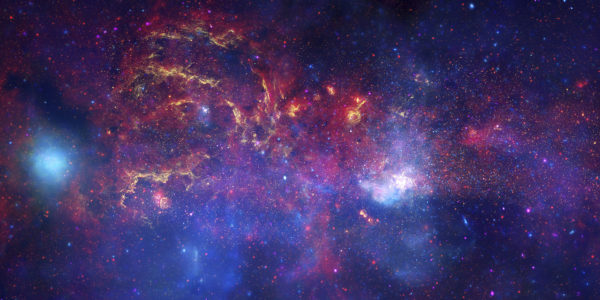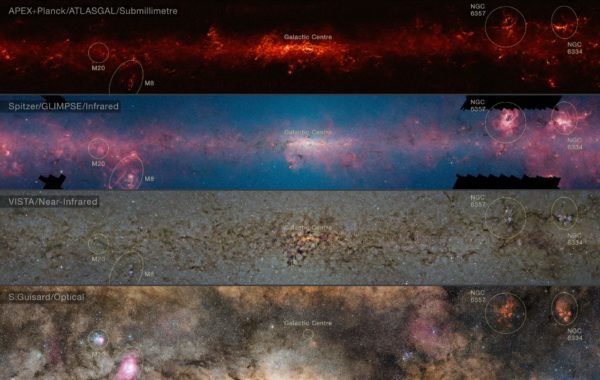"This suggests a lack of Cepheids in the inner 2.5 kpc region of the Galactic disc except the [Nuclear Stellar Disc]." -N. Matsunaga et al.
If you want to find where all the young stars in a galaxy are, you look for the densest regions of gas and dust: the locations where new stars and star forming regions are most likely to occur. In the Milky Way, like all spirals, we expect this to be in the galactic plane, along the spiral arms, and in the innermost region of the disk and bulge.
 A multiwavelength view of the very center of the Milky Way galaxy, including X-ray, visible, infrared and radio light. Image credit: NASA/JPL-Caltech/ESA/CXC/STScI.
A multiwavelength view of the very center of the Milky Way galaxy, including X-ray, visible, infrared and radio light. Image credit: NASA/JPL-Caltech/ESA/CXC/STScI.
When we look in the wavelengths capable of seeing this -- and looking for Cepheid variable stars as tracers -- we find that our picture is confirmed absolutely everywhere, except the inner galactic disk. For some reason, in the inner 8,000 light years of the Milky Way, we find that it's almost completely devoid of young stars. This lines up with what we see in the radio wavelengths, but it turned something we thought was well-understood into a surprising puzzle.
 The second panel from the top shows the Milky Way in radio light, showing a large area surrounding the galactic center with virtually no new star formation. Image credit: ESO / ATLASGAL Consortium / NASA / GLIMPSE Consortium / VVV Survey / ESA / Planck / D. Minniti / S. Guisard / Ignacio Toledo / Martin Kornmesser.
The second panel from the top shows the Milky Way in radio light, showing a large area surrounding the galactic center with virtually no new star formation. Image credit: ESO / ATLASGAL Consortium / NASA / GLIMPSE Consortium / VVV Survey / ESA / Planck / D. Minniti / S. Guisard / Ignacio Toledo / Martin Kornmesser.
What's the deal on this latest discovery? Find out over on Forbes!

Amazing the how distance becomes parsec and the recycle continues. Our life is a random gift of nature.
What do you smoke in that pipe, philip?
“Why this is the case is still a mystery, but better understanding the physics of the galactic center is one of astronomy’s primary science goals for the 21st century!”
Perhaps you should have two types of physics:
1)Non-galactic center physics, and
2)Galactic center physics.
The latter could be referred to as dark physics.
It could, if you didn't care that what you said had no meaning whatsoever.
There is no ignorance like the ignorance that says if science cannot yet explain something science has failed. That type of ignorance is demonstrated daily by sn.
God, meanwhile, explains nothing.
Could this be a result of a a galaxy merger in the distant past?